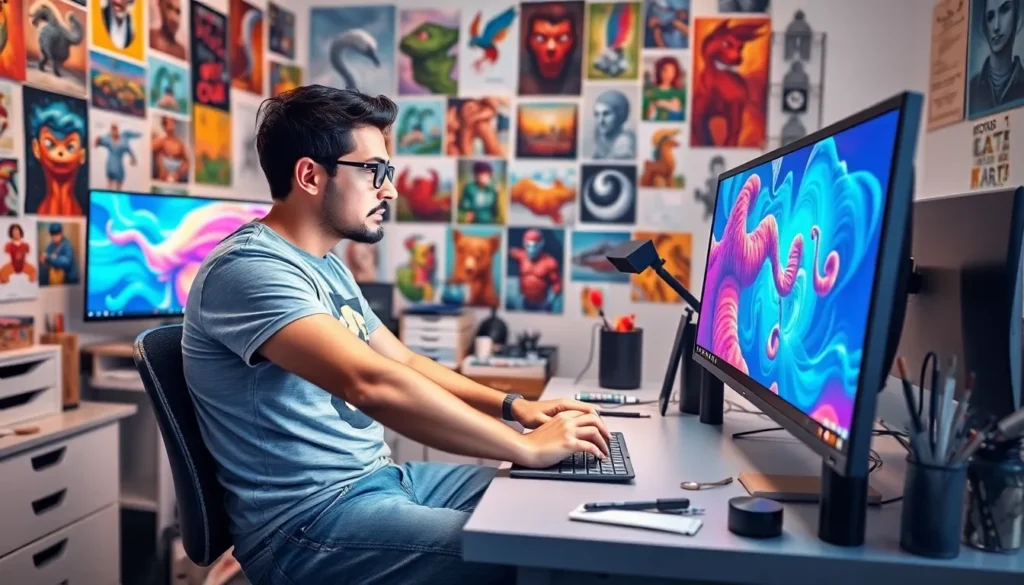In a world where digital art can be as valuable as a Picasso, creating an NFT is like discovering a treasure map leading to your own fortune. Picture this: you’ve got a unique piece of art, a catchy meme, or even a virtual cat wearing a top hat. With NFTs, you can transform that creativity into a digital asset that collectors will fight over—like kids at a candy store.
Create NFT
Non-Fungible Tokens (NFTs) have transformed the digital asset landscape, providing a way to own and trade unique items. Each NFT represents a distinct piece of content, making it impossible to interchange with others.
What Are NFTs?
NFTs are digital assets that signify ownership of specific items, often using blockchain technology for verification. Each token is unique and cannot be replaced, unlike cryptocurrencies such as Bitcoin or Ethereum. Creators mint NFTs to showcase their work, including art, music, and virtual collectibles. Ownership history remains transparent, ensuring buyers know previous owners and creators. This characteristic fosters trust and authenticity within digital markets.
Brief History of NFTs
NFTs first emerged in 2014 with the release of “Cryptokitties,” a game allowing users to buy, sell, and breed virtual cats. This innovation sparked interest and discussions around digital ownership. By 2021, several high-profile sales catapulted NFTs into mainstream awareness, including Beeple’s artwork selling for $69 million. The expansion of various platforms increased NFT accessibility, allowing artists and creators from diverse backgrounds to engage with digital assets. Today, NFTs continue to evolve, integrating into industries like gaming and entertainment, as they challenge traditional ownership concepts.
Steps to Create NFT

Creating an NFT involves several steps, which ensure a seamless process from conception to sale.
Choosing the Right Platform
Select a platform that aligns with specific needs. Popular options include OpenSea, Rarible, and Mintable, which cater to different audiences and types of NFTs. Each platform has unique features, such as transaction fees, community engagement, and user interface. Evaluating these factors helps determine the best fit for an artist or creator. Successful artists often explore multiple platforms to maximize exposure and sales opportunities.
Creating Digital Art or Asset
Develop a piece of digital art or asset that holds value. This work can range from visual art to music or virtual collectibles. Using tools like Adobe Illustrator for graphics or digital software for music enhances quality. Consider the target audience when creating art, ensuring it resonates with potential buyers. Unique and appealing content attracts collectors, emphasizing the importance of originality and creativity in the process.
Minting Your NFT
Minting transforms digital assets into NFTs on the chosen platform. This step involves uploading the asset and providing details, such as title, description, and royalties. Setting royalties allows artists to earn from future sales, ensuring ongoing revenue. Gas fees may apply depending on the platform and current network conditions. After minting, the NFT becomes part of the blockchain, making it verifiable and tradable. Successful minting showcases the creator’s commitment to maintaining authenticity and value.
Best Practices for NFT Creation
Creating an NFT requires attention to detail and strategic choices to stand out in a competitive market.
Ensuring Quality Artwork
Quality artwork significantly impacts an NFT’s success. Artists should focus on originality and technical skill when creating their pieces. Utilizing high-resolution images enhances visual appeal, making the NFT more attractive to potential buyers. Developing a unique style fosters recognition and helps build a personal brand. Using tools like Adobe Illustrator or Procreate can help artists refine their work. Testing different formats and collecting feedback from peers also proves beneficial. Ultimately, high-quality artwork not only attracts collectors but also establishes the artist’s credibility in the digital space.
Setting Appropriate Pricing
Setting prices wisely increases the chance of sales for NFTs. Researching similar artworks sets a reasonable pricing benchmark. Factors such as the artist’s reputation, artwork quality, and market demand play a role in determining price. Experimenting with tiered pricing can attract various types of buyers. Offering exclusive perks, like limited editions or special access, justifies higher prices. Adjusting prices according to market trends helps maintain competitiveness. Transparent pricing communicates to buyers and creates trust around the NFT. Ultimately, careful pricing strategies can enhance an NFT’s overall success.
Marketing Your NFT
Marketing NFTs effectively enhances visibility and attracts potential buyers. Utilizing various strategies can significantly influence sales outcomes.
Building an Online Presence
Establishing a strong online presence is crucial for visibility. Create profiles on platforms like Twitter, Instagram, and TikTok to showcase digital art. Regularly share updates about new creations and engage in relevant discussions. Collaborating with other artists allows cross-promotion and exposure to new audiences. Utilizing search engine optimization techniques can increase organic reach. Crafting an appealing website with an online portfolio is essential for professional presentation. Diversifying content types keeps the audience engaged, including behind-the-scenes insights or creation processes.
Engaging with the Community
Engagement strengthens relationships with potential buyers. Actively participating in NFT communities on Discord or Reddit fosters connections. Hosting virtual events like webinars or AMA sessions allows artists to directly interact with fans. Encouraging feedback promotes a collaborative spirit, enhancing customer loyalty. Offering giveaways can incentivize sharing and expand reach within the community. By consistently interacting with followers, artists build authentic connections that drive interest in their NFTs. Aligning with influencers or thought leaders in the NFT space can also amplify outreach.
Conclusion
Creating NFTs opens up a world of possibilities for artists and creators. By embracing the unique nature of digital assets they can tap into a lucrative market eager for originality and innovation. The journey from concept to minting is not just about technology but about understanding value and community engagement.
As the NFT landscape continues to evolve staying informed and adaptable is key. Artists should focus on building their brand while connecting with audiences through effective marketing strategies. With dedication and creativity the potential for success in the NFT space is immense.

